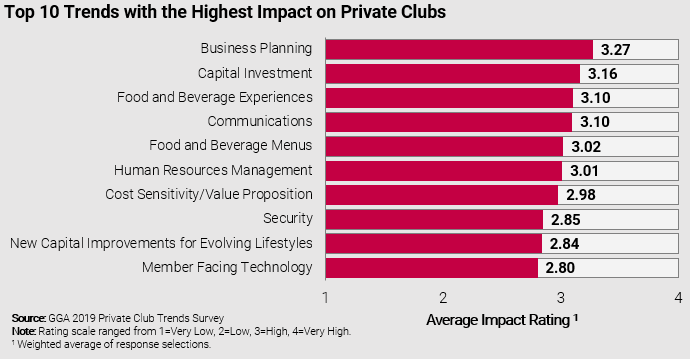However big or small the event, there’s always reason to inject creativity and innovation to make it memorable for all involved. This is an approach Medinah Country Club has pioneered for over 95 years. So, what are they doing, and what can you learn? We turned to General Manager and Chief Operating Officer, Robert Sereci, for the answers.
In what ways have you brought innovation and creativity to the events you have hosted?
While we have brought innovation to many events, at Medinah Country Club we view innovation as a strategic advantage that we leverage across all facets of club operations. From food and beverage to technology, innovation plays a critical role in our success.
Despite our significant recent investments in amenities, we realize that, ultimately, these amenities are only vehicles to facilitate relationships and strengthen our community.
Our approach to events focuses on larger, traditional club events like Easter, Mother’s Day and Halloween, while consistently developing smaller events, focused on appealing to a targeted demographic who share similar interests and passions.
We also work around the seasons. Many are surprised that a golf-centric club like Medinah hosts events around ice skating, sledding, and cross-country skiing in the winter months. But this keeps members engaged, mixing with other members and makes the club more a part of their everyday lives. We even host roller skating, where we convert our ballroom into a roller rink!
Family involvement is also key, and offers an opportunity for us to be creative. For instance, we invite families to join our executive chef for an educational experience as he taps our trees for maple syrup, to learn about egg production from our farm hens, and to learn how honey is harvested from our three bee colonies, all on our club property.
We also sprinkle in ingredients which are true to Medinah, and showcase the best of what we have to offer. Our Medinah Food Truck regularly roves around the property serving parties, and we use our portable wood burning oven or smoker to supplement indoor and outdoor club events.
Who drives this commitment to innovation, and why is it so integral at Medinah?
In our case, my team and I drive this commitment. I suspect this is not that different for most other clubs. Club Boards genuinely demand innovation from their management team, yet they embrace and find comfort in conformity. Clubs are notorious for conforming with the majority and have learned to embrace the status quo in order to align with the opinions and behaviors of neighboring clubs. This pressure to conform can have a significant negative impact on management’s engagement, creativity, and ability to innovate, and ultimately the club suffers.
Innovation is not important for innovation sake. As more clubs expand their offerings and amenities become ubiquitous, we, as clubs, must shift our focus from building structures to building memories. Like the corporate world outside our gates, we have migrated into an “experience economy,” where our members place greater importance on experience. Fitness centers, spas, and racquet courts are now the norm and very few members get impressed by these shiny new toys. Today’s members are looking for, and paying for, memorable unique experiences. These unique experiences are what makes successful clubs stand out in the eyes of the current and prospective membership.
How do you capture new, creative ideas AND make them happen?
Capturing ideas is the easy part – getting buy-in and execution is the hard part.
There is no shortage of ideas. My team and I look not only to our peers for ideas, but more importantly, we look at what others outside of our industry are doing and determine if and how it is applicable to us. The truth is, many of our innovative ideas at Medinah may be innovative for the club space, but in reality, they are almost common practice in the public space. Clubs are too quick to dismiss ideas from other segments by thinking “that would never work here.” While that may sometimes be true, we seek out those principles or ideas that would work and determine what we would need to do in order for those ideas to be successful at Medinah.
What’s your best example of bringing innovation to a high-profile event? What made it successful?
While many clubs go out of their way to squash nonconformity, at Medinah, we encourage it. I genuinely promote constructive nonconformity. That type of thinking is how we introduced the Tiny House Hospitality Package during the recent BMW Championship hosted at Medinah. The goals were twofold:
How can we create a unique memorable spectator experience and capture additional hospitality at a mid-range price point? The answer – place several Tiny Homes at specific locations on the golf course.
This was the pitch – Ever dream of watching a professional golf tournament from your backyard? Now you can. Introducing the Tiny House Hospitality Package for the 2019 BMW Championship. Invite your friends and colleagues to watch the top 70 players tee off just feet from your fenced backyard. In addition to witnessing the tournament up close, you will have access to a tiny house with all the accommodations of a home.
Not only was this the first time a Tiny House has been used in this way, but also the first time a Tiny House has been featured on a course during a professional tournament. This was a massive success and will likely now be a standard hospitality offering for future tournaments. The positive press we received was truly remarkable.
What else can other clubs learn from Medinah, whether they are staging high-profile events or member events?
In order to foster innovation, you must have a culture that not only encourages those who are innovative, but, more importantly, doesn’t penalize those who fail. Too many clubs focus on the ideas and innovation, and not enough on developing a culture of trust, where innovation and creativity is celebrated.
As the COO at Medinah, I have worked tirelessly to strengthen the trust between myself and the board. The board has provided me with a large safety net. In return, I have provided my team with an even larger safety net, allowing them to take risks and challenge the status quo. There are very few mistakes my team can make that I cannot get them out of.
Clubs must become comfortable with the unknown. If you want to accomplish something unique and memorable, you must be willing to take on risk. In general, clubs are culturally rigid and, as a result, are very risk averse. Club boards and members have a very low tolerance for failure and so club managers take fewer risks, thus, innovation comes to a standstill. Arguably, clubs with greater recognition and resources can afford to take more risk, but I believe the exact opposite to be true. When a small, unrecognizable club fails, the city may be aware; however, when a club with a global brand fails, the whole world will know.












